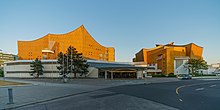Edgar Wisniewski
Edgar Wisniewski (born September 4, 1930 in Stolp , Pomerania , today Słupsk, Poland, † April 25, 2007 in Berlin ) was a German architect . He was a student and later partner of Hans Scharoun .
Life
Wisniewski was born in 1930 as the youngest of two children (his sister Roswitha was born in 1926 ) of the architect Bruno Wisniewski and the pianist Edith Wisniewski (née Berndt) in Stolp . After the Second World War , the family fled to Berlin in September 1945 . His interest in music and architecture was shaped by his parents' home. He justified the decision to study architecture as a "more sensible solution, because architecture seemed less risky to me professionally than music at the time."
From 1950 to 1957 he studied at the TU Berlin with Hans Scharoun , whose employee and later, congenial partner he then became. He was therefore involved in the overall urban planning concept of the Kulturforum Berlin from the start. In 1963 the Philharmonie Berlin was opened as the first building , for whose construction Wisniewski was the artistic director. The New State Library opened in 1978 . Scharoun died in the planning phase in 1972. There was a contractual agreement between Wisniewski and Scharoun, which said that in the event of death, the other should continue the work.
The next thing that was established between 1979 and 1984 was the State Institute for Music Research (SIM) with the Musical Instrument Museum (MIM). Wisniewski planned and realized the chamber music hall between 1984 and 1987 based on an idea sketch by Scharoun. Up until then, there had been long debates in the House of Representatives about its implementation, until Richard von Weizsäcker, as Governing Mayor , finally made a decision in favor of the building. In addition to the main idea of “music in the center”, the architectural prerequisites for the performance of contemporary music were important to Wisniewski. B. by music galleries for room music. For this purpose he consulted with composers like Luigi Nono, who also wrote works for the building and its possibilities. The hall's acoustics, which are considered excellent, are praised by numerous ensembles and conductors around the world.
The fall of the Berlin Wall , which stood in the immediate vicinity of the Kulturforum, and the redevelopment of Potsdamer Platz completely changed the overall urban planning context. The artist guest house of the Senate, which was also planned by Scharoun and was part of the competition for the construction of the State Library, was never realized. Wisniewski worked to the end for the completion of the overall concept, which had many critics from the beginning and triggered numerous debates.
In addition to his work for the Berlin Kulturforum, Edgar Wisniewski built residential buildings. In the late 1970s, the group of terraced houses in Berlin-Schlachtensee (Kirchblick 12a-c), where Wisniewski lived with his family, was built. After the fall of the Wall, he planned and implemented extensions, extensions and conversions of so-called "prefabricated buildings" in the former GDR, especially in Prenzlau , in the sense of organic settlement construction ; extensive plans for Neubrandenburg were not implemented.
honors and awards
- 1997: Federal Cross of Merit 1st Class of the Order of Merit of the Federal Republic of Germany
literature
- Edgar Wisniewski: The Berlin Philharmonic and its chamber music hall. The concert hall as the central space , Gebrüder Mann Verlag 1993, ISBN 3786117144
- Edgar Wisniewski u. a .: Paths to music. Published on the occasion of the opening of the new house , State Institute for Music Research Prussian Cultural Heritage 1984, ISBN 3922378048
swell
- ^ Catholic St. Otto Church in Stolp, Pomerania Baptism 1930 No. 25 September 28, 1930
- ^ Family Wisniewski from Stolp, Biographical Sketches in: Külzer Heft, Volume No. 10, Page 49, Szczecin 2015
- ↑ Scharoun's man for the artistic. ( Memento from September 30, 2007 in the Internet Archive ) Berliner Morgenpost, January 5, 2007.
Web links
- Edgar Wisniewski. In: arch INFORM .
- Short bio at baunetz.de
- Interview with Edgar Wisniewski , taz April 25, 2005
- Scharoun's man for the arts , Berliner Morgenpost, January 5, 2007
- Obituary (Welt online May 1, 2007)
- Edgar Wisniewski archive in the archive of the Academy of Arts, Berlin
| personal data | |
|---|---|
| SURNAME | Wisniewski, Edgar |
| BRIEF DESCRIPTION | German architect |
| DATE OF BIRTH | 4th September 1930 |
| PLACE OF BIRTH | Stumble |
| DATE OF DEATH | April 25, 2007 |
| Place of death | Berlin |

